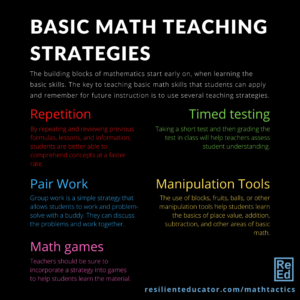
Math can be challenging for many students. At the same time, integrating research-based teaching strategies can significantly improve their understanding of the material throughout their primary and secondary education.
Research-based math strategies, such as using hands-on manipulatives or incorporating real-world examples, can make basic mathematical concepts more accessible and engaging for students of all ages.
Adapting these numeracy strategies to the needs of individual students can have a significant impact in helping them build a strong foundation in math and set them up for ongoing success.
Basic math teaching tactics
Repetition
A simple strategy teachers can use to improve math skills is repetition. By repeating and reviewing previous formulas, lessons, and information, students are better able to comprehend concepts at a faster rate.
According to Professor W. Stephen Wilson from Johns Hopkins University, the core concepts of basic math must be mastered before students are able to move into a more advanced study. Repetition is a simple tool that makes it easier for students to master the concepts without wasting time. According to the University of Minnesota, daily re-looping or reviews will bring the previous lesson back into the spotlight and allow teachers to build on those previous skills.
Timed testing
When teachers are moving beyond the simple concepts of numbers into addition, subtraction, multiplication and division, it is important to incorporate timed tests that review the previous class or several classes.
Taking a short test and then grading the test in class will help teachers assess student understanding. When the test shows that students are answering more questions correctly within the time period, teachers are able to determine that students have mastered the basic skills.
Pair work
Mathematics is not limited to learning from a textbook, lessons, or testing strategy. Students have different learning styles and need to have lessons that help improve all styles of learning to get the best results.
Group work is a simple strategy that allows students to work and problem-solve with a buddy. When a teacher has provided the basic instruction, it’s helpful to split the class into pairs or groups to work on problems.
Since the pairs are working as a team, the students can discuss the problems and work together to solve the issues. The goal of pair work is to teach students critical thinking skills that are necessary for future math problems and real life.
Manipulation tools
The use of blocks, fruits, balls, or other manipulation tools help students learn the basics of place value, addition, subtraction, and other areas of basic math. According to Kate Nonesuch on the National Adult Learning Database of Canada, manipulation tools help slow down the process of problem solving so that students are able to fully understand the information.
Manipulation tools make it easier for students to learn and understand basic skills. These are ideal when students learn best through hands-on experience and building, rather than traditional lessons and repetition.
Math games
Reinforcing the information learned in class is not always the easiest task for teachers, but math games provide the opportunity to make the lesson interesting and encourage students to remember the concepts.
Depending on the class size, computer availability, and the lesson being taught, games can vary. Teachers can use computer games for the particular skills or can opt to use class games to make the lesson more fun. Teachers should be sure to incorporate a strategy into games to help students learn the material.
Fundamental mathematical concepts students should learn by 12th grade
Though the specific curricula may vary by location and school district, typical mathematical concepts students are expected to have learned upon completing secondary education include:
- Algebraic expressions and equations. Graduating students should be able to understand, manipulate, and solve algebraic expressions and equations.
- Functions. Seniors should be able to understand and work with linear, quadratic, and exponential functions.
- Geometry. By the completion of 12th grade, students should have a working knowledge of geometric concepts such as points, lines, angles, triangles, quadrilaterals, circles, and three-dimensional shapes.
- Trigonometry. Graduates should be fluent in trigonometric functions and able to solve problems involving angles and lengths in triangles.
- Statistics and probability. Graduating seniors should be able to understand and analyze simple statistical data and the concepts involved in the calculation of probabilities.
- Calculus. Though mastery of this subject is generally beyond the scope of secondary education, graduating seniors should have a functional understanding of calculus concepts such as limits, derivatives, and integrals.
Early education: research-based math instruction for kindergarten
The youngest students are at the onset of their math literacy, and teaching strategies for kindergarten math must be developmentally appropriate. Start with imparting basic ideas such as counting and number recognition before moving on to more advanced concepts.
It is well established that younger students are concrete learners and can more easily grasp mathematical concepts through hands-on and visual approaches. The use of manipulatives, such as counting bears of different colors, can be used to teach basic counting and sorting concepts.
Unifix or linking cubes are effective methods for teaching the fundamentals of counting, addition, and subtraction. Similarly, the use of base ten blocks efficiently introduces students to the concepts of units, tens, and hundreds.
Connecting mathematical concepts to real-life examples can make them more meaningful and easier to grasp for kindergarten students, while incorporating games or activities has the added benefit of making math instruction more fun and engaging.
Counting or shopping games involving bills and coins of different values supports an increased understanding of counting, addition, and subtraction. Likewise, cooking games involving ingredients can help teach concepts of measurement such as weight and volume.
Encouraging students to work together on math activities in pairs or small groups can help them develop problem-solving skills and the ability to communicate mathematical concepts.
Ongoing support and reinforcement of new ideas are essential to help kindergarten students retain what they have learned. Regular and consistent review of learned material can reveal whether individual students need additional instructions or practice.
Essential mathematics topics for primary school: research-based strategies for grades 1-6
Continuing elementary math strategies should build on what early childhood students have already learned. Games and real-world examples continue to be effective, as are hands-on and interactive activities involving manipulatives. These should gradually become more complex and involve more functions with variable solutions.
Activities should be combined with visual aids like pictures and diagrams. These visual aids help introduce students to abstract representations of concepts that they first encountered via concrete methods.
The use of repetition and review becomes developmentally appropriate and can help students comprehend and retain essential functions more rapidly.
Young students develop at different rates and respond better to various approaches. Numeracy strategies in the classroom should draw on an assortment of methods during early primary education.
The continued use of manipulatives and visual aids is most effective when employed alongside traditional methods such as worksheets and classroom instruction. Technology-based instruction, which often involves online math games, virtual manipulatives, and videos, can further help keep students engaged and actively learning.
Ongoing primary education: research-based math strategies for middle school
Middle school typically refers to grades 6-8, though some schools may include Grade 9 students. This is a time of significant transition and developmental growth for students as they tackle increasingly advanced coursework, greater responsibility, and more independence in their ongoing instruction.
Linking mathematical concepts to the real world remains an effective teaching method. However, real-world examples should reflect the growing sophistication and abilities of older primary school students. Budgeting and financial planning exercises help reinforce concepts such as decimals and percentages.
Games and activities continue to help engage middle school students but should reflect their increased capabilities. More complex card or board games can help students practice new math skills. Virtual games using technology-based methods are similarly effective.
Collaborative learning furthers critical thinking and problem-solving skills. One excellent way to keep students involved is by encouraging them to work in pairs or small groups using educational apps or online resources.
Ongoing review of learned material is essential to greater understanding and retention. Students should be provided with individual support and tailored practice to reinforce concepts that may be challenging.
Secondary education: research-based math strategies for high school students
As students progress through high school and prepare for a university education, independence and individual responsibility become essential. Encouraging students to take ownership of their ongoing education and math studies will help enable them to successfully meet the expectations and demands placed on them in higher education.
Provide opportunities for the personal exploration of mathematical concepts through individual study and solo projects. This can be especially effective when coupled with collaborative efforts, such as having students review each other’s work and discuss any errors or differences in understanding.
Using increasingly complex real-world situations, such as statistical analysis of sports or finance, emphasizes the utility of mathematical concepts in everyday life. Similarly, algebra teaching strategies incorporating technology such as loan calculators and online stock trading simulations increase engagement and retention of learned concepts for secondary school students.
Intervention strategies for learners experiencing barriers in mathematics
Numeracy intervention strategies are useful to help students struggling with math. Practical approaches will depend on each student’s specific needs. They should be tailored to individual learning styles and the concepts with which that student is experiencing difficulties.
Individualized instruction and one-on-one tutoring may be effective for single students having difficulty with concepts understood by most of a class. Forming small groups for instruction and collaborative study is a more efficient and targeted method for students struggling with similar or related concepts.
A math intervention strategies list should include tools that address the needs of individual students. Visual aids like graphs and diagrams and adaptive software that responds to a particular student’s performance are effective techniques. Students who need to solidify their understanding of specific topics or improve individual skills will benefit from additional practice opportunities.
For students struggling with previously introduced concepts, reviewing the material using different approaches, examples, and explanations can be helpful. The most effective math intervention strategies will vary depending on each student’s specific needs and learning style. Students may require different approaches to find what works best for their challenges.
Final thoughts: a tailored approach to individual needs
There are many proven, research-based strategies for teaching math. Approaches involving the incorporation of real-world examples to make concepts more relatable and the use of technology and online resources to enhance learning remain effective throughout primary and secondary education. Of course, these should be adapted to ensure they’re developmentally appropriate for students as they progress.
Overall, teachers should encourage students to persevere through the challenges they may face in understanding math concepts while promoting a growth mindset and providing ongoing support. The ultimate key to success lies in balancing traditional and modern methods and using various approaches to suit each student’s individual needs and learning styles.
Categorized as: Tips for Teachers and Classroom Resources
Tagged as: Math and Science

